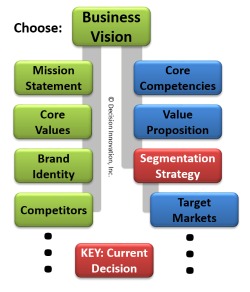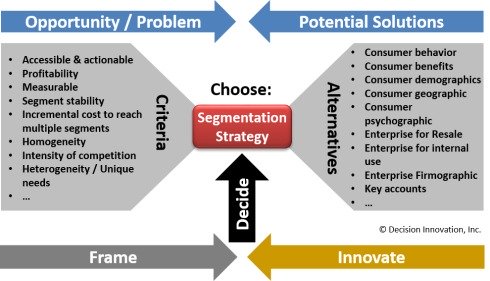Choosing an Effective Segmentation Strategy
 A segmentation strategy helps to limit business or product scope to the set of people you are most likely to be able to serve, bringing focus to the needs that should be targeted in your marketing communication. This can be particularly important for a startup business where the value proposition must be validated before resources are exhausted and the business fails.
A segmentation strategy helps to limit business or product scope to the set of people you are most likely to be able to serve, bringing focus to the needs that should be targeted in your marketing communication. This can be particularly important for a startup business where the value proposition must be validated before resources are exhausted and the business fails.
Segment strategies range from mass market (appeal to the whole market) to mass customization (market size of one). Because it is difficult to learn from customers the exact motivations for their purchase, a specific set of segmentation attributes are used that provide correlation to likely purchase behavior. Customer traits in a segment will also suggest likelihood of achieving other business objectives, such as profitability and sustainability.
Decisions related to the choice of segmentation strategy
 Market segmentation is most often used to clarify requirements for a target market/customer decision. This decision is especially helpful in providing focus for a startup or turn-around business where it is important to identify and prioritize the market opportunities with the highest probability of success.
Market segmentation is most often used to clarify requirements for a target market/customer decision. This decision is especially helpful in providing focus for a startup or turn-around business where it is important to identify and prioritize the market opportunities with the highest probability of success.
Business vision, mission, and identity decisions provide guidance for this decision. Choices for company overall value proposition and core competencies are often developed and refined together (in parallel) to the market segmentation strategy, helping to clarify possible product or service fit to the market opportunities.
Types of market segmentation to consider
When marketing to consumers, a segmentation strategy will often target consumers using one or more of the following attributes:
- Consumer behavior - This market segmentation strategy uses differences in consumption behavior of different groups of consumers based on their life-styles, patterns of buying and using, patterns of spending money or time, etc. Segment consumption behavior is used to suggest possible needs or desires.
- Consumer benefits - Segmentation is based on specific differences in consumer benefits that can be targeted by products, services and/or marketing from the business.
- Consumer demographics - Segments are determined based on differences in consumer demographic factors. These factors normally align with specific needs and wants. Age is a common demographic attribute.
- Consumer geographic - Physical location becomes the key aspect for this segmentation strategy. Different geographic regions often have different product preferences. Knowing where the company sells products and services enables focus of advertising to those locations.
- Consumer psychographic - Market segmentation is based on differences in social class, lifestyle, or personality characteristics that can be targeted. Promotion often suggests how products or services become expressions of the customer's lifestyle or personality.
Strategies for segmentation, when targeting businesses, consider the needs within an enterprise. Marketing is directed at a smaller number of people, typically responsible for larger purchase decisions. Common segmenting approaches include:
- Enterprise for Resale - This is a segmentation strategy that targets value added resellers (VARs) that would resell products or services with no change.
- Enterprise for internal use - Segments target enterprises that would use delivered products or services for improving internal productivity, or for use as part of their service delivery.
- Enterprise Firmographic (industry grouping) - Specific attributes within companies or industries (e.g. industry, role, region...) are used as a way to target needs in business to business (e.g. healthcare) and government markets. This is similar to demographic segmentation used in consumer businesses.
- Key accounts - Big companies or organizations can provide opportunities large enough to justify dedicated marketing to those key accounts.
Additional strategies and hybrids are possible, but alternatives may have less data available, making it more difficult to determine the sizes of segment populations.
Evaluating alternatives for the market segmentation strategy
 The following criteria, when prioritized, can be used to identify the segmenting approach best suited to the company situation and market environment.
The following criteria, when prioritized, can be used to identify the segmenting approach best suited to the company situation and market environment.
- Accessible & actionable - Capabilities for marketing, products/services and distribution should allow serving the proposed segments. The segments must be reachable through communication and expected distribution channels.
- Profitability - Selected segments should have enough profit potential to justify developing and maintaining a marketing mix. (Population multiplied by spending authority)
- Measurable - The differentiating attributes of the segments should enable identification and measurement of customers in the segments. Source data should be available to estimate the size of the segment population.
- Segment stability - The segments should be stable enough to enable success within likely product or service development lifecycles. Greater stability can contribute to sustainability of the business.
- Incremental cost to reach multiple segments - Minimizing incremental development and marketing costs to reach additional segments can prevent failure if marketing does not attract the most likely customers.
- Homogeneity - Segments within the strategy should identify customers with similar needs for the products or services that will respond to the marketing mix.
- Intensity of competition - The segmentation strategy should provide opportunities for likely products or services to compete effectively. If the intensity of competition is destructive (destroying value for all players) then you want to avoid this strategy.
- Heterogeneity / Unique needs - Customers in different segments should have unique needs to justify separate offerings of products, marketing, or both.
Increasing clarity of customer needs and wants

Choosing a segmentation strategy is a scoping decision that helps focus early efforts of a business on the customer opportunities most likely to generate success. An effective segmentation will:
- Provide a source of advantage against larger competitors
- Direct early product, service and marketing development on specific customer needs and wants where success is more likely
- Improve sales, branding, distribution and advertising
- Limit expenses during early stages of business development
- Enhance and accelerate downstream decisions by limiting scope
The focus created with a segmentation strategy enables continuing business as initial segments are served successfully.

Return from Segmentation Strategy to Business Decision Making
